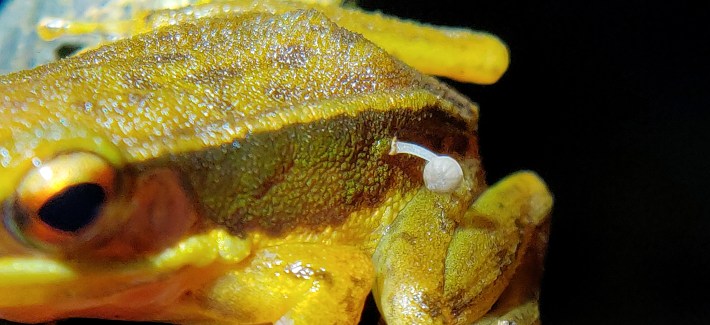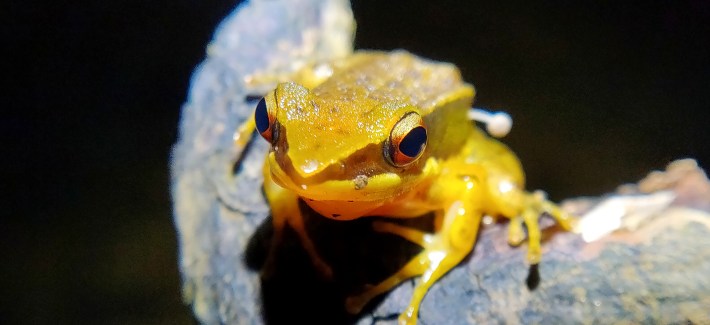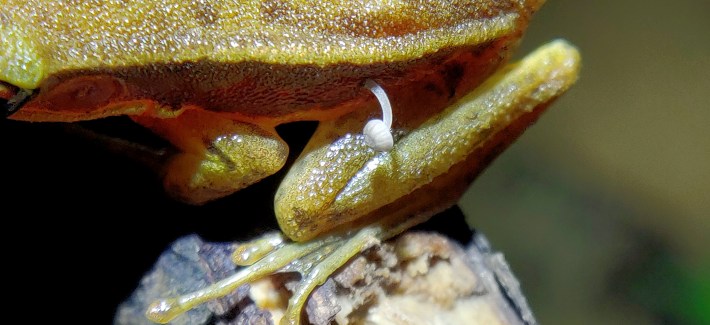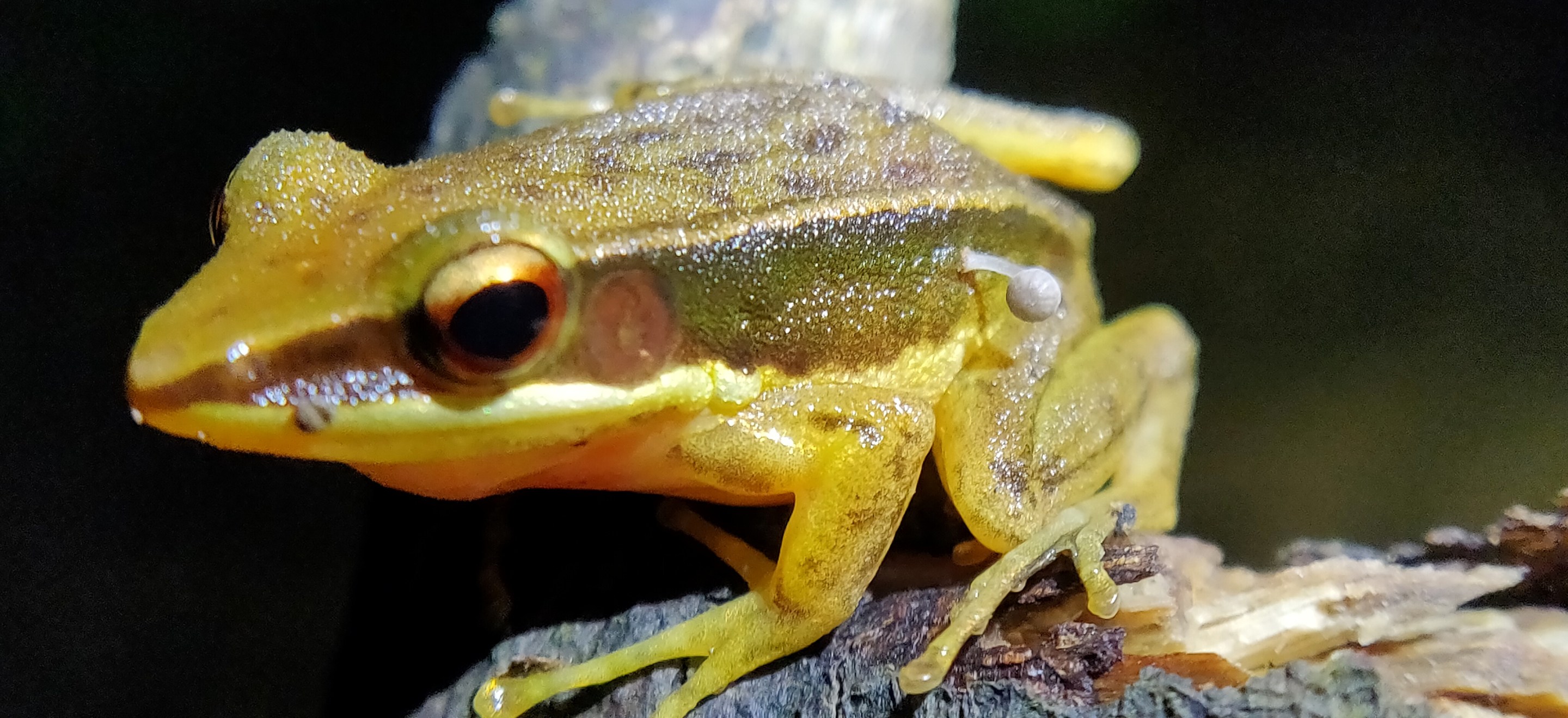The single mushroom sprouted from the golden flank of a frog like a palm tree from a clichéd drawing of a desert island. It had a small, slightly puckered cap and a stalk as pale and translucent as skim milk. At least outwardly, the frog did not mind its fungal companion. It moved around its perch on a twig several times, sometimes changing positions. The mushroom remained firmly affixed to the frog's side. "That's when we knew it was not just sticking on but has sprouted out from its flank," said Lohit Y.T., a naturalist and a river and wetlands specialist at World Wildlife Fund–India. "I found it quite odd," he added.
In June, Lohit and a group of nature enthusiasts had come to the tropical foothills of the Western Ghats in Karnataka, India, to go herping—birding, but for reptiles and amphibians. Monsoons had drenched the forests, and the hills were alive with the croaks of frogs. The crew knew about a pond off the side of the road and wandered over to get closer to the croaking, which turned out to be a congregation of Rao’s intermediate golden-backed frogs. "They were all over the place," Lohit said. "When I was observing them, one frog was resting on a twig quite near the periphery which caught my eye because it had something on it." This frog was mushroom frog.

The herpers observed the frog and its unlikely sidekick for nearly 20 minutes. And they did not disturb the duo beyond a brief photoshoot. "We were out in the field with no equipment with an impending rainstorm," Lohit said, adding that his only thought was to document the frog to share the finding with the scientific community. (In the past, his herping group discovered a new species of spider.) "We simply want the frog to be safe," he added.
Later on, Lohit uploaded the photo to community science sites to see if anyone could identify the mushroom, and enthusiasts suggested it could be a bonnet mushroom in the genus Mycena. In January, Lohit and Chinmay C. Maliye, another naturalist in the herping group, published their observation, which they say is the first report of a mushroom sprouting from a live frog, in the journal Reptiles & Amphibians.

Beyond the picturesque charm of the photos, as if nature had penned a children's book, the observation surprised some scientists. Frogs and fungus are often a fatal pairing. The deadly chytrid fungus Batrachochytrium dendrobatidis, or Bd, has driven dozens of amphibian species to extinction and devastated populations worldwide. Bd infects amphibians when they are exposed to spores in the water, eventually peeling off their skin. In their paper, Lohit and Maliye wrote that Batrachochytrium is present in many India's frog hotspots. But while it is a fungus, it does not result in any mushrooms. "Can say that I never saw any indication of a "toadstool" (emphasis hers) either macroscopically or microscopically when looking for Bd," Joyce E. Longcore, a mycologist at the University of Maine and the first person first person to isolate Bd, wrote in an email.
Rabern Simmons, the curator of fungi at the Purdue University Herbaria, first learned about the mushroom frog through a Google alert he'd set up for "Batrachochytrium." He recalled another photo he'd seen nearly 20 years ago, of a living smooth helmeted iguana whose body prickled with the small buds of a white-capped slime mold. Simmons was not convinced by the identification of the fungus as a bonnet mushroom from the photos alone. He believes it "almost undoubtedly" belongs to the large phylum Basidiomycota, one of the large mushroom-forming groups in the fungal kingdom. But without any samples of the mushroom's flesh, the exact identity of the frog's passenger remains obscured.
"Have I ever seen anything like this before? Not at this scale," Simmons said. "On a living organism? Just sprouting off its side? Just both of them seemingly content?" he added.

Simmons was not shocked by the notion of fungi growing on a creature. Much of the fungi that grows on living creatures, frogs or otherwise, is microscopic. Microscopic chytrid fungi grow in the layers of an amphibian's skin. On people, the yeast-like fungi Malassezia feeds on scalp oils and contributes to dandruff. The fungus Candida albicans normally lives on our skin and inside our body, but when it grows out of control it can cause yeast infections or thrush. Rather, Simmons was shocked that a mushroom—the fleshy, enlarged, and potentially spore-bearing fruiting body of a fungus—could have sprouted and grown so big on a frog.
"It is different, because this is such a complex, sexual state of an organism," Simmons said, adding that yeast fungi are generally single-celled organisms that undergo fission to reproduce. But sexual reproduction in fungi is "very complex," he said, involving "more than just two mating types in a lot of cases." He believes for this mushroom to exist, two compatible mating types must have formed a dikaryon, which is a cell with the nucleus of both partners. "For a mushroom to be growing on this frog, there had to at some point been that formation of a dikaryonic individual that found its way—onto? into? I don't know what exactly—this frog," Simmons said. "And then was able to sustain enough nutrition from the biofilm on the frog, or maybe a nick in the frog's side to form a mushroom."
As Simmons points out, it is unclear how deeply the mushroom is growing into the frog. He wondered aloud if the mushroom could be parasitizing the frog. "There has to be some sort of anchoring, and, you know, dispersal of tissue in order to sustain that amount of growth on another living organism," he said. "It can't just conjure matter from nowhere.

For now, Simmons's biggest question—how often does something like this happen?—remains. "Unfortunately there's not an army of mycologists, roaming the land and looking for oddities," he said. But he hopes the frog could be a gateway to more of these observations, and elevate the profile of fungi in the public eye. "These frogs and these larger animals, these are the charismatic megafauna," he said. "When a fungus can hop onto something like that, and ride its coattails, literally in this case, it gets people's attention."






